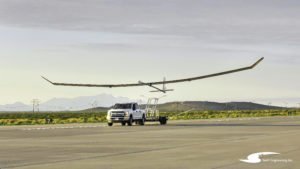Source: Swift
Swift Engineering is banking on the success of the high altitude long endurance (HALE) drone system.
In partnership with NASA’s Ames Research Center, Swift recently completed a maiden flight at New Mexico’s Spaceport America. The project also performed a full-system UAS check, as well as validating the drone’s configuration for high-altitude continuous surveillance missions.
Designed to operate unmanned at 70,000 feet, the HALE drone offers 24-hour persistent and stable upper atmosphere operations for commercial and military surveillance, monitoring, communications, and security applications. An alternative to satellites, the 72-foot solar-powered air vehicle weighs less than 180 pounds and can safely carry up to 15-pound payloads for missions.
Andrew Streett, Swift’s Vice President of Technology noted:
“The partnership with NASA’s earth science team is significant. Using the agency’s mission cases, we developed a cost-efficient power and propulsion system that can withstand harsh temperatures, radiation, and stratospheric conditions, while providing and storing enough energy to enable persistent long-duration flights. The calculations from the flight test validates all of our safety and design requirements.”
HALE received two technology patents and received airworthiness certifications from NASA as well as the FAA‘s Certificate of Authorization (COA), enabling the drone to fly in commercial airspace.
“The applications of this technology will usher in a new era of data acceleration. Swift is able to deliver what no other industry or defense contractor can provide in the US market. I am extremely proud of our team and our great partners at NASA for this remarkable feat of innovation. We are excited about our global commercialization plans,” says Rick Heise, President and CEO of Swift Engineering.
What is NASA’s Ames Center?
“NASA’s Ames Research Center in California’s Silicon Valley has set out to create a research platform that will help manage large numbers of drones flying at low altitude along with other airspace users. Known as UAS Traffic Management, or UTM, the goal is to create a system that can integrate drones safely and efficiently into air traffic that is already flying in low-altitude airspace. That way, package delivery and fun flights won’t interfere with helicopters, airplanes, nearby airports or even safety drones being flown by first responders helping to save lives.”
Jason is a longstanding contributor to DroneLife with an avid interest in all things tech. He focuses on anti-drone technologies and the public safety sector; police, fire, and search and rescue.
Beginning his career as a journalist in 1996, Jason has since written and edited thousands of engaging news articles, blog posts, press releases and online content.
Email Jason
TWITTER:@JasonPReagan
Subscribe to DroneLife here.
https://dronelife.com/2020/09/09/swift-hale-drone-reaches-new-heights-with-nasa/
 Unmanned Aerial Vehicle The latest drone news
Unmanned Aerial Vehicle The latest drone news




